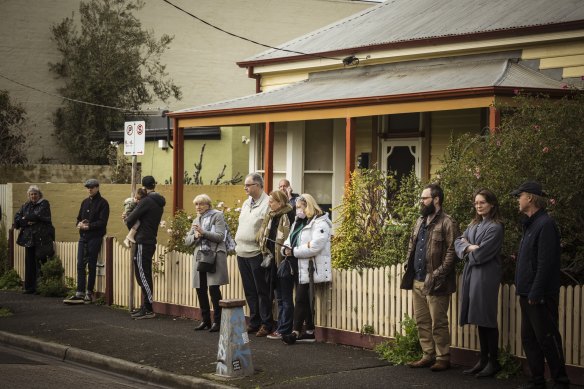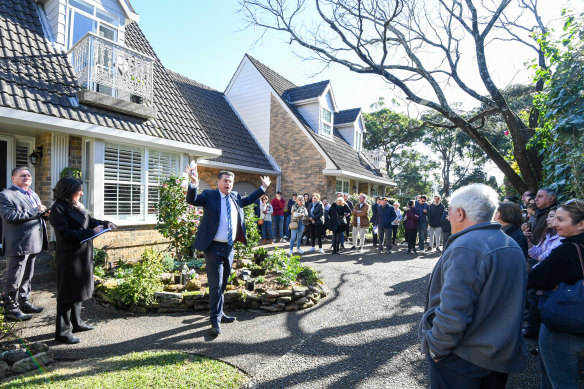This was published 2 years ago
Sorry, home owners, but this is when you should have sold your house
By Kate Burke
Is it a good time to sell your house? Home owners might not want to hear it, but the best time to sell was last year.
Rapidly rising interest rates have reduced buyer demand to below-average levels this winter, new analysis shows, but buyer interest was on the decline well before that in most markets.

Rising interest rates have accelerated the pullback in buyer demand.Credit: Chris Hopkins
The best time for Sydney sellers to hit the market was well over a year ago, Domain analysis shows, because buyer demand for both houses and units peaked in March 2021. Demand is now at its lowest level in three years, outside the market’s usual summer holiday hiatus.
Demand for Melbourne units peaked that same month, while demand for houses peaked in October, as did the demand for Brisbane houses and units.
Demand for Hobart houses was first to peak, in February 2021, while some markets peaked much later, such as units in Adelaide and Perth that took until February 2022.
The Domain Buyer Demand Indicator (BDI) measures search behaviour on domain.com.au to identify active buyers who are more likely to purchase, such as those who shortlist a property or send an inquiry. It tracks changes in demand over time.
Domain chief of research and economics Dr Nicola Powell said the market had been cooling since last year, when demand peaked in October across the combined capital cities. Demand in regional Australia peaked in the same month for houses, and in January 2021 for units.
“Largely speaking, if you wanted to have the highest volume of buyers for your property, that would have been during a month of peak buyer demand,” she said.
The drop in buyer demand was first concentrated in Sydney and Melbourne, but had spread, Powell said. Demand softened across the capital cities and regional areas over winter, and was below the three-year average in most markets over the 30 days to August 20.
Demand for houses in Melbourne now is down 14.5 per cent compared to a typical August, and down 11 per cent in Sydney and 17.8 per cent in Brisbane. It dropped more than 20 per cent in Canberra and Perth.
Powell said demand had moderated as the higher cost of debt and inflation pressures hit buyer borrowing capacity. An increased supply of homes for sale had also reduced competition.
She added Sydney’s earlier peak reflected the city’s greater affordability challenges, and said the harbour city was further along the price cycle.
Powell expected to see the seasonal lift in buyer demand that came with spring, but felt interest would still be on the soft side, resulting in greater opportunities for buyers.
“The opportunities are there, we have overall stock rising, greater choice on the market, and days on market are lengthening out, which means buyers can come to the market knowing they have greater time to contemplate their purchases and make the right decision,” Powell said.

While quality homes are still selling well, buyer demand is below the three-year average.Credit: Peter Rae
“For sellers, it’s a timely reminder that the market has moved and pricing your property right is important, if they want to secure a quick sale.”
St George Bank chief economist Besa Deda said the market slowdown had begun in the first half of 2021. Rapid price growth had led to stretched affordability, and this combined with rising fixed mortgage rates and an increase to the interest rate serviceability buffer — which affected borrowing power — had cooled buyer demand.
That slowdown was then accelerated by growing expectations for cash rate hikes earlier this year, Deda said, and the four consecutive rate rises that followed. She expected demand would continue to weaken as rates climb.
“Whilst you have that tightening [rate] cycle continuing, dwelling prices are going to soften, as will demand from buyers, because affordability is being impacted by higher mortgage rates,” she said.
Buyer’s advocate Rich Harvey, the chief executive of propertybuyer.com.au, said already cooling demand quickly dissipated as the cash rate climbed.
“The outcome is that there are significantly less people at auctions … a lot more prior [to auction] offers being accepted, and significantly fewer people at open homes,” Harvey said.
“Last year we would have 50 people going through a home … I did some [this week] where there were three groups, on a weekend there might be five or six, or you might be lucky to get 10.”
His team saw buyer demand drop off in Sydney first, then Melbourne, and more recently in Brisbane. However, he noted good quality properties were still selling well.
While rate hikes had “an immediate and detrimental” effect on buyer borrowing power, property price declines meant some clients could now purchase homes previously out of their budget.